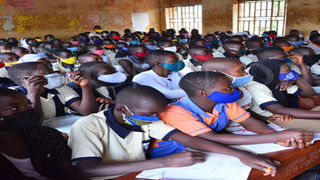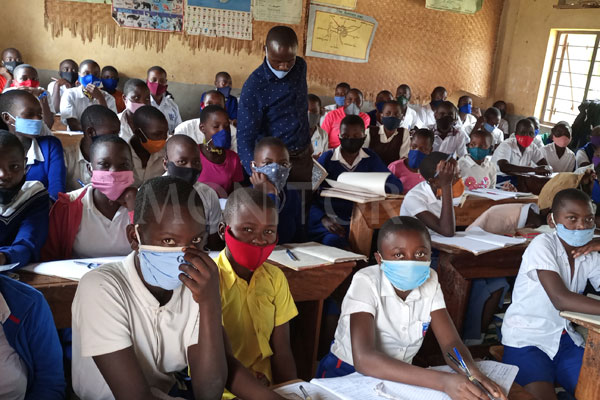
A packed class at Muhorro Muslim Primary School in Kagadi District. PHOTO/ALEX TUMUHIMBISE
|Education
Prime
Upcountry schools grapple with congested classrooms
What you need to know:
- The Ministry of Education planned to provide tents for the learners in case of high numbers but this has not yet been implemented.
Private and government primary and secondary schools across the country are grappling with congested classrooms, which has left them struggling to adhere to standard operating procedures (SoPs), an investigation by this publication has revealed.
Schools were in March 2020 closed to combat the spread of Covid-19, but were reopened on January 10, and subjected to strict protocols, including erection of tents at congested schools to allow social distancing.
However, this has not ben achieved in many upcountry schools.
In Busia District, for example, enrolment in many schools has increased by more than 200 compared to the figures before the lockdown, leading to congestion in the classrooms.
At Madibira Primary School in Busia Municipality, authorities are struggling to adhere to the Covid-19 protocols.
Ms Phoebe Nandera, the deputy head teacher, at the weekend said enrolment has increased from 2,232 learners before the lockdown to 2,431, adding that the school expects to register more pupils before this term ends.
“Many of the pupils we are getting have come from private primary schools that have failed to reopen; and as a result, our numbers are increasing every other day,” she said.
SOPs hard to implement
Ms Nandera added that the high numbers are making it hard for the school to observe SOPs.
“For instance, a desk that used to host three learners now has between four and five learners, which compromises the social distancing rule,” she said.
“Our pupils continue to wear masks and hand wash, but when it comes to social distancing, this has been compromised because of lack of enough space,” the head teacher added.

Some of the pupils of Nyarilo Primary School in Koboko Municipality attend lessons under a tree. PHOTO/RASHUL ADIDI
Numbers have also increased at Busia Border, Busia Integrated, Buchicha, and Arubaine primary schools.
Whereas the Ministry of Education planned to provide tents for the learners in case of high numbers, this has not been implemented.
Pupils continue to crowd the classrooms, putting their lives at risk of infections in case of an outbreak.
The high numbers have also put a strain on pit-latrine facilities, classrooms, desks, and teachers.
“We don’t have enough teachers, desks, pit-latrines and classrooms to cater for the high numbers of pupils, if possible, authorities should add us more teachers, classrooms, desks, and latrines to cater for the high numbers of pupils,” Ms Nandera requested.
In Jinja District, the head teacher of Jinja Senior Secondary School, Mr Isaac Balimusangayo, said the population is more than what they expected, but “they are in control” as far as adhering to the Covid SOPs are concerned.
According to Mr Balimusangayo, the school was previously operating under small capacity, so the increased population came when there was already space.
“The school was already having classes that were not being used; so, when the number of students exceeded what we expected, we only utilised the redundant classrooms as we observed SOPs,’’ he said.
In Luweero, the district education officer, Ms Florence Bbosa, confirmed that public schools, including Bombo Common and Luweero Boys’ primary schools have registered big numbers.
“Many schools have already asked for additional desks, among other basics,” she said.
This newspaper has also learnt that these schools turned away many parents who had brought in more children because they could not be accommodated. Wobulenzi Public School, for example, has a population of 1,800 pupils, up from 1,400 before the lockdown.
In Mityana District, the most affected are the government-aided primary schools in Kalanagalo and Ssekanyonyi sub-counties.
Kalangalo Church of Uganda Primary School has so far enroled 600 pupils, crowding the few available classrooms.
Mr David Kiboombojo, the head teacher, said besides the few classrooms, many pupils are now sitting on the floor due to lack of desks.
Mr John Membe, the Ssekanyonyi Sub-county chairperson, said although many parents have taken their children to school, shortage of furniture remains a big challenge.
“I commend the parents for taking their children to school and promise that the issue of desks will soon be handled,” Mr Membe said.
Mr Kifampa Hamidu, the district inspector of schools, said they are aware of the increased enrollment, adding that plans are underway to provide tents to accommodate excess learners.
Mr Axam Mudduse, an educationist and director of Mpigi Parents’ Primary School, said congestion has not yet occurred despite the rising population in many schools in the area.
“The situation has not become worse because there are many learners who are still stuck at home due to lack of fees; but since we have many schools that have come up, I am sure all of them will be absorbed if they show up,” he said.
In Ntungamo District, school heads said implementing social distancing is “extremely difficult” since they remained with the same structures they had before the lockdown.
The head teacher of Kyamate Secondary School, Mr Emmanuel Arinaitwe, said as the number of students joining secondary schools increases, the classrooms are not enlarged to that capacity.
At Kyamate Primary School, the head teacher, Mr Robert Atuzareirwe, said: “We now have 381 pupils, up from less than 100 before the Covid-induced lockdown, but I think we can accommodate the pupils.”
Mr Joseph Bazirake, the deputy head teacher of Kyamuhunga Central Primary School, Kyamuhunga Town Council, Bushenyi District, said the school is struggling to accommodate its 822 pupils , including 131 in boarding section.

A teacher conducts a class at Kabingo Model Primary School in Bushenyi District in early February 2022. PHOTO/ZADOCK AMANYISA
Class under trees
In Koboko District, the big number of learners in some of the schools has exerted more pressure on the available structures, and due to inadequate number of classrooms, some schools have resorted to teaching the learners under trees.
Some of the affected include Nyarilo, Gbukutu Islamic, Noor Islamic, Apa, Teremunga, and Birijaku primary schools, among others.
Mr Michael Aluma, the head teacher of Nyarilo Primary School in Koboko Municipality, said reopening of the institution has mounted pressure on the furniture and sanitary facilities as most structures are under renovation.
“The number of learners in the last two weeks has been overwhelming and one thing that we can’t observe is social distancing because the learners are congested yet we want to ensure that everybody attends lessons,” he said.
Mr Aluma added that some of the classroom blocks are under renovation with funding from European Union Trust Fund Project, while six have been demolished to pave way for renovation.
According to Mr Aluma, the school is expecting more than 3,500 learners this year, up from 2,840 before its closure in March 2020.
Ms Zabibu Ariye, the head teacher of Gbukutu Islamic Primary School, said they don’t have enough classrooms, and one of their big blocks is under renovation.
Mr David Dimba, the Koboko Municipal education officer, said the number of learners reporting back to government-aided schools is overwhelming.
He, however, added that the schools that were under renovation have been affected more, making accommodation of the learners hard.
“We have realised that the pupil-classroom ratio is very high, and in some schools, about two to three classes are merged due to shortage of classrooms,” he said.
In Yumbe District, some of the schools are experiencing a lot of challenges in accommodating the learners due to high enrolment.
Mr Mohammed Angoliga, the head teacher of Barakala Primary School, said there is congestion in Primary One to Primary Four classes, with as many as 100 pupils in each class.
As a result, they are thinking of making other learners sit under tree shades to decongest the classes, but they will be hit by a shortage of teachers.

A Primary One class at Barakala Primary School in Yumbe District. At least seven pupils sit on each desk. PHOTO/ROBERT ELEMA
In Teso Sub-region, several primary schools are filled beyond their holding capacity as the classroom spaces, initially accommodating only a given number, are now being overwhelmed, with some having more than 300 pupils in a single classroom.
Mr Paul Omer, the Soroti East Division chairperson, said Opuyo Primary School in Soroti City East, which previously had less than 100 children, now has nearly 1,200 pupils.
“With those numbers, the school has only 70 desks and surprisingly, the operation funds which the government has sent are far too less to handle the problems these schools are faced with,” he said. Mr Korum Eyoku, the head teacher of Kaberamaido Primary School, told Daily Monitor that the school has currently enroled 1,934 pupils.
In Adjumani District, Mr Patrick Jurugo, the head teacher of Ayiri Primary School in Ukusijoni Sub-county, said the school has enroled 865 pupils both refugees and host community from Primary One to Primary Seven, but the most congested class is Primary One with 200 registered pupils and 115 unregistered.
However, due to congestion in Primary One and Primary Four, they have improvised learning outside, but unfortunately, there are only 10 teachers for the whole school while the rest of the classes have an enrolment of between 90 to 100 pupils, except for Primary Seven, which has 28 pupils.
Mr Jurugo said they have already reported the congestion and shortage of teachers to the district education office.
Situation in Adjumani District
At Mungula Primary School in Mungula refugee settlement, Itirikwa Sub-county, a high number of pupils has been registered and most of the classrooms are congested, with each classroom having more than 120 pupils.
Mr Abraham Makual Manyok, the refugee welfare councillor one (RWC1) of Mungula refugee settlement, said over the past two years, many children have developed an interest in learning, while those who were in nursery have “grown” and many have joined primary.
Mr Philip Akuku Kayakaya, the senior education officer of Adjumani District, said the department has done a comprehensive audit of the sector after the reopening, and is yet to submit its findings to the chief administrative officer for action. He, however, noted that 90 percent of teachers in secondary schools have turned up, while only 70 percent of the teachers in primary are back.
*Compiled by Philip Wafula, Tausi Nakato, Abubaker Kirunda, David Awori, Al-Mahdi Ssenkabirwa, Dan Wandera, Brian Adams Kesiime, Zadock Amanyisa, Felix Ainebyoona, Perez Rumanzi, Elly Katahinga, Ronald Kabanza, Simon Peter Emwamu, Emmanuel Eumu, George Muron, Rashul Adidi, Robert Elema, Marko Taibot & Tobbias Jolly Owiny



